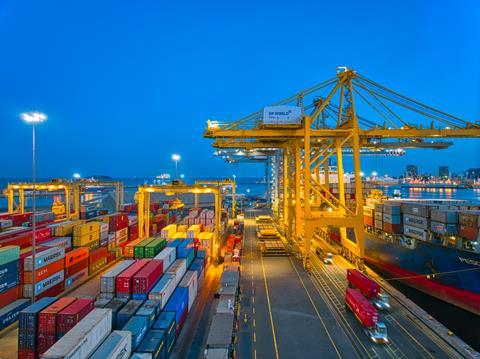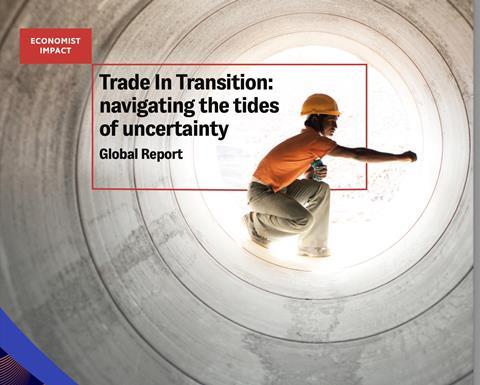The latest Trade in Transition research paper released by Economist Impact, and supported by DP World, looks at globalisation and the current disruptions that are reconfiguring global trading and the supply chain.

Those disruptions include heightened geopolitical risk and the impact of climate change, but they also include new digital technology, which is enabling companies to cut supply chain costs. These factors are shifting the focus from efficiency gains to strategic resilience and adaptability, according to the findings of the research.
‘Trade in Transition: Navigating the Tides of Uncertainty’, the fourth research paper released by The Economist’s policy research unit, is based on a global survey of 3,500 senior executives into trade and supply chain practices.
One of the ten key findings from the survey is that companies are opting for fewer supply chain partnerships. Diversification has been a primary supply chain strategy in recent years but 26% of companies opted to work with fewer suppliers, according to the latest results, up by 16 percentage points from the previous year.
The authors of the paper point out that on the face of it, this is counterintuitive. Setting up dual supply chains leads to a diversification of suppliers but businesses that are focused more on building capacity are those working with fewer suppliers. The report says that this trend towards streamlined supplier engagement is consistent across regions and sectors, reflecting a structural evolution in supply chain practices.
Diversity and resilience
Bill Garrett, head of the automotive vertical at DP World, told Automotive Logistics that logistics providers had to be able to adapt to the differing strategies of OEMs. “Some of them are going in the direction of multiple-source points for the same part or assembly product, while others go for the longer-term contract with a single supplier. A lot of that is to do with where that supplier is located and what the transit time is.”
Garrett pointed out that if an OEM had a Chinese supplier feeding parts into North America there was a need for a contingency plan with another supplier. However, if they are feeding a US plant locally it is a different story. “It’s geographic and down to whether an OEM is comfortable that the supplier can produce the volume needed and be consistent,” he said. “Then there is the international complexity of supply chain and the timeframe involved.”
The other factor is the cost of the goods, according to Garrett. “If it is a very expensive product you don’t want to have a long transit time. You are going to put that closer to home and source it near where you are at. We are seeing a mix across car companies of how this is being handled today. It is not one size fits all.”
Transport costs
One of the other key findings in the Trade in Transition report is that transport costs are predicted to be the leading obstacle for firms aiming to increase exports in 2024.
Shipping rates have in fact fallen from the peak in 2021/22 and the report stated that an expected surge in cargo ship availability would further lower costs. However, the looming rise in oil prices because of production cuts threatens to counter those gains, according to the report.
There is also the well-documented, long-term problem of the driver shortage, which was exacerbated by Covid. That has been recorded by a number of prominent European vehicle-handling ports as a contributory factor in the longer dwell times and congestion seen through 2023.
Furthermore, the report points to last-mile delivery, which accounts for a substantial portion of shipping and overall supply chain expenses (53% and 41%, respectively according to the research), is becoming more critical with an increase in online sales.
“Navigating these challenges – fluctuating costs, logistical deficits and changing consumer behaviour – remains an essential facet of contemporary trade and commerce,” stated the report.
Garrett said that DP World was seeing an increase in safety stocks at suppliers that had longer supply chains. “We are seeing people hold more material, with more material in transit as you might expect, to cushion that supply chain and ensure there are no disruptions.”
Read the full interview with Bill Garrett, head of the automotive vertical at DP World
Digital tools to cut costs
Managing cost while building resilience into the supply chain meant companies were still in favour of just-in-case delivery models. Economist Impact said that in 2023, companies maintained nine weeks of inventory, compared to 10.1 in 2022 and 8.9 in 2021, indicating a recalibration last, likely because of the cost of maintaining higher inventories. The research found that 34% of company executives are using digital tools to improve inventory management, the top strategy for cutting supply chain costs.
The research also found that 35% of companies have employed AI to optimise inventory levels, emphasising the rising reliance on technological solutions. “With companies losing around $1.8 trillion annually due to inventory issues, efficient inventory management is crucial,” said the research paper.
The authors report that artificial intelligence (AI) has become “an indispensable tool for 98% of executives”. It said that 34% of companies are banking on AI to curtail overall trade expenses as supply chain costs escalate. The adept use of AI tools in supply chain management has enabled companies to reduce logistics costs, slash inventory levels and elevate service levels. The research also found that AI is anticipated “to bolster supply chain planning and minimise disruptions, solidifying its pivotal role in reshaping the future of efficient and resilient supply chain operations”.
Delivery times were the top priority in supply chain management over the last year, according to the findings of the paper, with 24% of executives stating that a key outcome of their strategies had been a faster time to market. “This urgency stems from consumer expectations for swift order fulfilment, compelling businesses to reduce lead times to enhance customer satisfaction and potentially bolster retention,” stated the report.


























![Global[1]](https://d3n5uof8vony13.cloudfront.net/Pictures/web/a/d/s/global1_726550.svgz)














No comments yet